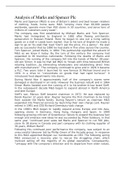Analysis of Marks and Spencer Plc
Marks and Spencer (M&S) is one of Britain’s oldest and best known retailers
of clothing, foods, home ware. M&S “employ more than 60,000 people
worldwide, operate more than 450 stores in 30 countries, and serve tens of
millions of customers every week”.
The company was first established by Michael Marks and Tom Spencer.
Marks had immigrated to England in 1882 after fleeing anti-Semitic
persecution in Russian Poland. Here he began to eke out a living selling
goods on a stall in Leeds town market. Due to his lack of English he made a
sign to go on his stall that read “Don’t ask the price, it’s a penny”. His stall
was so successful that by 1890 he had stalls in five cities across the country.
Tom Spencer, joined Marks, in 1894. This partnership signified the advent of
M&S as we know it today. By the turn of the century the company had
expanded to 36 branches nationwide. Following the deaths of Marks and
Spencer, the running of the company fell into the hands of Marks’ 28-year-
old son Simon. It was he that led M&S to “break with time-honoured British
retailing tradition…by eliminating wholesalers and establishing direct links
with manufacturers”. The company continued to grow and in 1926 it became
a PLC. Two years later it launched its now famous St Michael brand and in
1931 in a drive to “concentrate on goods that had rapid turnover” it
introduced food departments into stores.
During World War II approximately half of the company’s stores were
damaged or destroyed in air raids. However the business rebuilt and in 1964
Simon Marks handed over the running of it to his brother-in-law Israel Sieff.
In the subsequent decade M&S began to expand abroad in North America
and later Europe.
Sieff’s son, Marcus Sieff became chairman in 1972. He was replaced by
Derek Rayner 12 years later. Rayner became the first chairman to be hired
from outside the Marks family. During Rayner’s tenure as chairman M&S
expanded into financial services by launching their own charge card. Rayner
retired in 1991 and CEO Richard Greenbury took charge.
In the 1990’s M&S began to rapidly expand across Europe and into Asia,
opening stores in Germany, Hong Kong, Hungary and Spain. In 1999
following growing criticism of Greenburys’ failure to expand the business fast
enough and embrace new ideas he was succeeded by, Peter Salsbury. In that
same year “continued poor sales led Marks and Spencer to cut 700 jobs,
close its 38 stores in Canada and part company with its clothing supplier of
30 years, William Baird”.
Following this continued poor performance the company, was subject to an
unsuccessful takeover bid by Phillip Green of the Arcadia group. In response
to this M&S appointed Belgian Luc Vandevelde as CEO. The following spring
M&S announced a recovery plan to rescue the struggling chain, which
involved selling off the majority of its global operations. Consequently,
“unhappy with the company’s direction and its departure from older values,
, Marks and Spencer board members Sir David Sieff (the last remaining
founder member), Sir Ralph Robins and Sir Michael Perry left the board in
July 2001”.
Within a year and a half of Vandevelde’s appointment “profits began rising,
but although at the time Vandevelde was credited with a revival, it proved to
be short-lived”, because by 2004 sales had fallen again and the brand had
lost some of its credibility. In light of this it was felt drastic changes were
needed and in May 2004 Stuart Rose, formerly head of Arcadia, was named
CEO. Since his appointment Rose has instituted change programmes within
the organisation and given it new strategic direction. The effects of these
changes are already beginning to be seen and M&S is showing clear signs of
recovery. However it is too early to say whether this improvement is
sustainable.
M&S was set up and run by a family for a long part of its history, its values
and culture derived from that. For many years it was viewed as being very
patriarchal and inward looking. The perception people had of the company
up until the 1980’s was of quality, affordability and reliability, embodied in
the St Michael brand. During this time leadership of the business was very
strong but inward focused. However, recent changes in the market place
have presented a great challenge to the company which it is still addressing.
PERCEPTION
According to Huczynski and Buchanan “it is our perception of reality that
shapes and directs our behaviour, not some objective understanding of it”.
Marks and Spencer’s corporate objectives are incorporated in its mission
statement. This outlines what the business is and what it should be. Mission
statements set out in writing what the firm wants to achieve and often
include information on the values of the business. M&S outlines its core
business as clothing and Food. Its financial objectives is to deliver
shareholder value in terms of increase returns, but also in terms of increase
sales and market share in retailing. It beliefs and values are outlined as “Our
customers continue to see Marks & Spencer as the place to shop for special
food, produced to exacting standards”. M&S also sees its workforce as an
important part of its plan and also considers modernising its stores as a key
corporate objective.
Vision: The standard against which all others are measured
Mission: Making aspirational quality accessible to all
Values: Quality, value, service, innovation and trust
M&S also outlines its corporate social responsibility in its mission statement
and considers the needs of other stakeholders too.
Customer Perception
Once established, from the customers’ point of view, M&S was considered
the epitome of quality, affordability and reliability which reached its apogee
in the 50’s and 60’s when customers used to scramble to acquire M&S’s
reproductions of catwalk fashion. M&S’s clothes lines became so popular that




